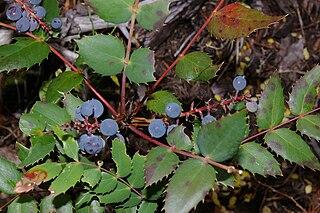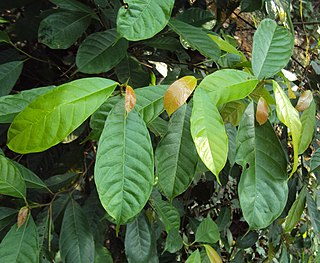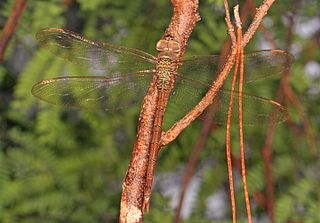
The bufflehead is a small sea duck of the genus Bucephala, the goldeneyes. This species was first described by Carl Linnaeus in his landmark 1758 10th edition of Systema Naturae as Anas albeola.

Argyreia nervosa is a perennial climbing vine native to the Indian subcontinent and introduced to numerous areas worldwide, including Hawaii, Africa, and the Caribbean. Though it can be invasive, it is often prized for its aesthetic and medicinal value. Common names include Hawaiian baby woodrose, adhoguda अधोगुडा or vidhara विधारा (Sanskrit), elephant creeper and woolly morning glory. Its seeds are known for their powerful entheogenic properties, greater or similar to those of Ipomoea species, with users reporting significant psychedelic and spiritual experiences. The two botanical varieties are A. n. var. nervosa described here, and A. n. var. speciosa, which are used in Ayurvedic medicine for their medicinal value.

Nepenthes albomarginata is a tropical pitcher plant native to Borneo, Peninsular Malaysia, and Sumatra.

Berberis nervosa, commonly known as dwarf Oregon-grape, Cascade barberry, Cascade Oregon-grape, or dull Oregon-grape, is a flowering plant native to the northwest coast of North America from southern British Columbia south to central California, with an isolated population inland in northern Idaho. It is especially common in second growth, Douglas-fir or western redcedar forests, making use of those pools of sunlight that intermittently reach the ground.

Psychotria is a genus of flowering plants in the family Rubiaceae. It contains 1,582 species and is therefore one of the largest genera of flowering plants. The genus has a pantropical distribution and members of the genus are small understorey trees in tropical forests. Some species are endangered or facing extinction due to deforestation, especially species of central Africa and the Pacific.

Elattostachys is a genus of about 21 species of trees known to science, constituting part of the plant family Sapindaceae.

Verticillium albo-atrum is a plant pathogen with many hosts.

Swertia is a genus in the gentian family containing plants sometimes referred to as the felworts. Some species bear very showy purple and blue flowers. Many members of this genus have medicinal and cultural purposes.

Guettarda is a plant genus in the family Rubiaceae. Most of these plants are known by the common name velvetseed.

Helicia is a genus of 110 species of trees and shrubs, constituting part of the plant family Proteaceae. They grow naturally in rainforests throughout tropical South and Southeast Asia, including India, Sri Lanka, Indochina, Peninsular Malaysia to New Guinea and as far south as New South Wales.
Hopea nervosa is a species of plant in the family Dipterocarpaceae. It is found in Sumatra, Peninsular Malaysia and Borneo.
Horsfieldia nervosa is a species of plant in the family Myristicaceae. It is a tree endemic to Borneo where it is confined to Sarawak.
Isoglossa nervosa is a species of plant in the family Acanthaceae. It is an herbaceous perennial or subshrub native to southeastern Nigeria, Cameroon, and Bioko island in Equatorial Guinea. Its natural habitat is tropical montane forest from 2,000 to 2,950 meters elevation.
Pseuduvaria nervosa is a species of plant in the Annonaceae family. It is a tree endemic to Peninsular Malaysia.
Trivalvaria nervosa is a species of plant in the family Annonaceae. It is a tree endemic to Peninsular Malaysia.

Mount Hamiguitan is a mountain located in the province of Davao Oriental, Philippines. It has a height of 1,620 metres (5,315 ft). The mountain and its vicinity has one of the most diverse wildlife populations in the country. Among the wildlife found in the area are Philippine eagles and several species of Nepenthes. Some of the latter, such as the Nepenthes peltata and Nepenthes micramphora, are endemic to the area. The mountain has a protected forest area of approximately 2,000 hectares. This woodland is noted for its unique pygmy forest of century-old trees in ultramafic soil, with many endangered, endemic and rare species of flora and fauna.

Psychotria nervosa, also known as Seminole balsamo or wild coffee, is a shade tolerant medium-sized shrub native to Florida as well as the West Indies and Central and South America. It produces a "small, red, ellipsoid fruit" that resembles "the true coffee bean" in shape and attract birds. Its maximum height ranges from approximately 4–10 feet.

Ficus nervosa is a tree in the family Moraceae which grows up to a height of 35 metres. It is native to southern China, Taiwan and tropical Asia. The tree is grown in coffee plantations for shade.

Gynacantha nervosa, the twilight darner, is a species of darner in the dragonfly family Aeshnidae. It is found in the Caribbean Sea, Central America, North America, and South America.
Serruria nervosa, the fluted spiderhead, is a flowering shrub that belongs to the genus Serruria and forms part of the fynbos. The plant is endemic to the Western Cape and occurs from the Kleinrivierberge to the Elim plain and up to the coast. The shrub is small, upright and grows only 30 cm high and flowers from July to November















